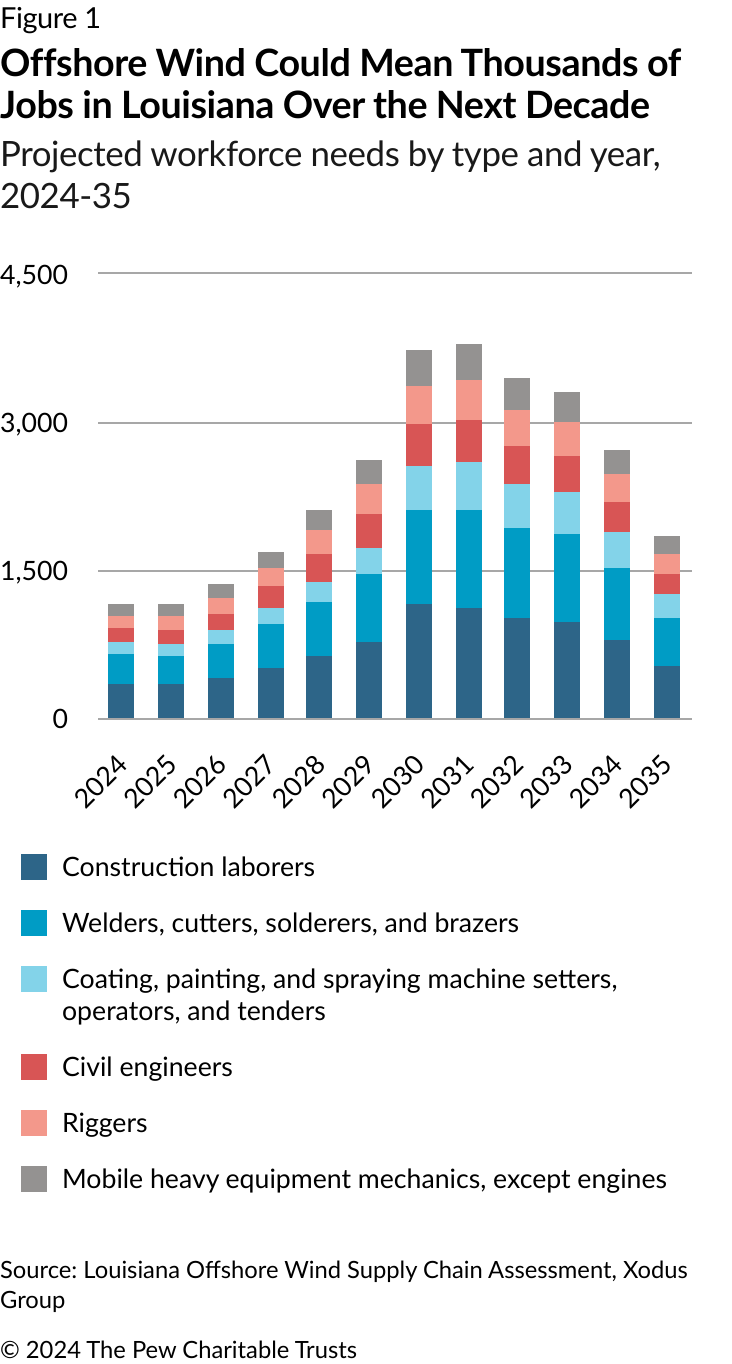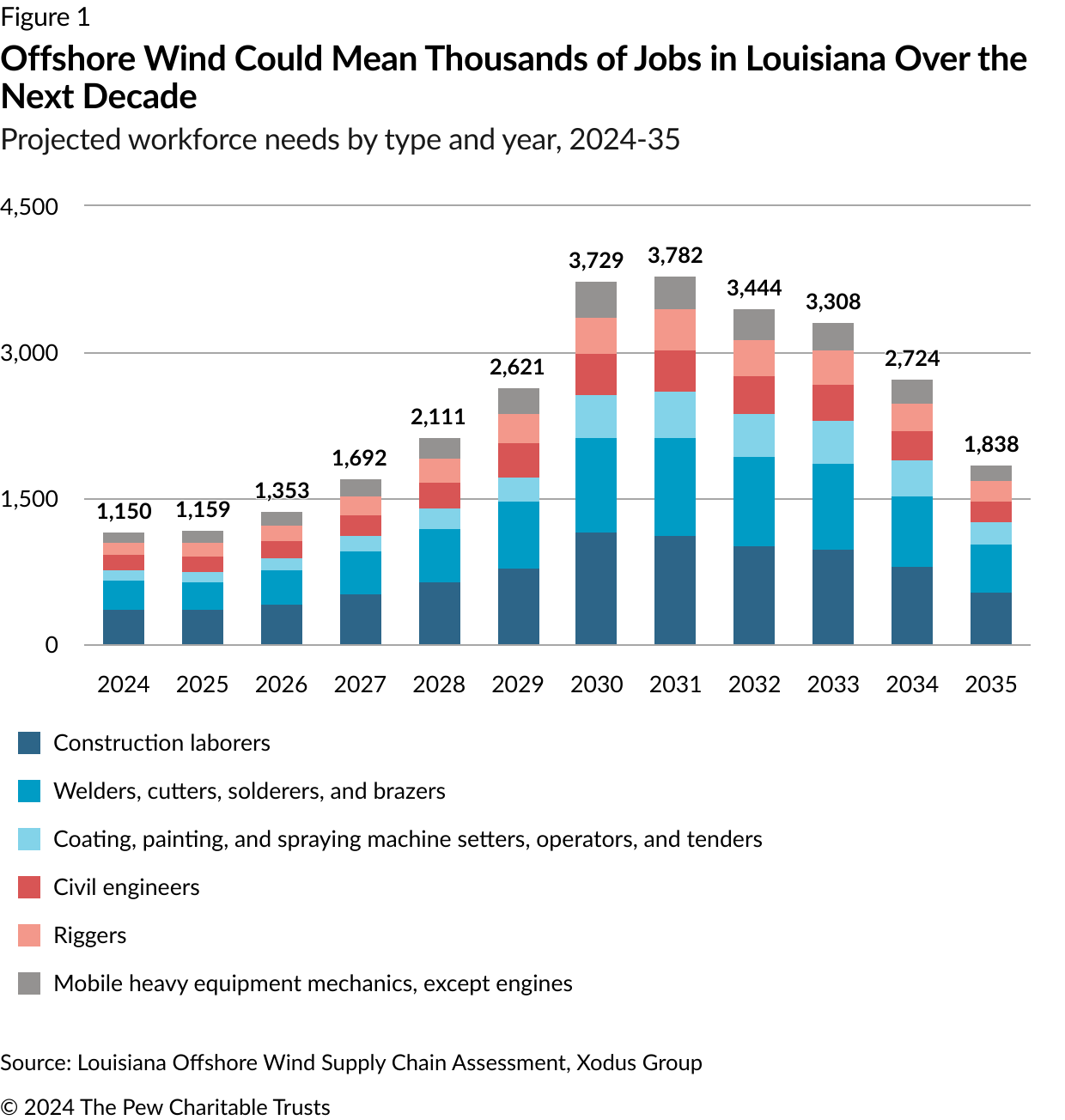Louisiana Primed to Take Helm of Offshore Wind Supply Chain
New report shows how the state can maximize economic development, jobs

Louisiana, already renowned for its energy prowess, is poised to harness the potential of another segment of the energy industry: offshore wind. Since the first U.S. offshore wind farm came online off the Atlantic Coast in 2016, Louisiana businesses have been a pivotal part of the supply chain for offshore energy projects, helping to design and build equipment and vessels. And now, with experts anticipating continued private investment of more than $100 billion and the creation of up to 50,000 jobs, Louisiana could expand its influence and reap substantial economic benefits from this burgeoning industry.
A new report, “Louisiana Offshore Wind Supply Chain Assessment,” released April 25 by the Southeastern Wind Coalition, Greater New Orleans Inc., the Center for Planning Excellence, and The Pew Charitable Trusts in collaboration with global energy consultancy Xodus Group, underscores the significant boon that expansion of Louisiana’s offshore wind industry and supply chain represents for businesses and workers in the state.
For example, the report estimates that by 2031, Louisiana’s export potential and procurement goals could generate more than 3,700 jobs across manufacturing, shipbuilding, installation and commissioning, and operations and maintenance. (See Figure 1.) Further, as the industry continues to grow nationwide, Louisiana businesses and workers could see ongoing benefits.

By leveraging its existing expertise and infrastructure assets, Louisiana can carve out a significant role in building and servicing the domestic supply chain for offshore wind development across the Southeast region and the nation. Among the key findings in the report:
- At least 15 Louisiana companies have already supplied goods and services for offshore wind projects.
- Industries adjacent to offshore wind employ more than 60,000 Louisiana workers.
- More than 100 existing fabrication and manufacturing assets could support offshore wind development if coupled with investments to retrain workers or retool or expand their operations.
- Louisiana’s offshore services sector includes at least 175 companies with expertise in planning, installation, operations, and decommissioning for offshore oil and gas that could be applicable for offshore wind.
The report also illustrates Louisiana’s readiness to expand its offshore energy portfolio, identifying companies across the state that have relevant experience for, or could supply products or services to, the offshore wind industry. (See Figure 2.)
The report also provides specific recommendations aimed at securing Louisiana’s position in this rapidly expanding industry and maximizing the economic gains for its businesses and workforce:
Maximize export opportunities: Louisiana’s existing expertise in offshore construction and manufacturing can help it seize near-term export opportunities to develop wind projects along the East Coast while bolstering the state’s capacity to support future offshore wind development in the Gulf of Mexico. The state should strengthen its business networks to position Louisiana businesses for large contracts.
Invest in the workforce and job sites that are offshore-ready: Over 450 Louisiana businesses are “offshore-ready,” meaning they could provide goods and services for the offshore wind industry. Workforce investment in offshore wind can accelerate economic growth, employment, and social benefit to communities most in need. To be ready to fill the industry’s supply chain needs, Louisiana should build awareness about offshore wind job opportunities and support worker training and certification programs.
Upgrade ports and support shipbuilding: Supporting the offshore wind industry can help to diversify the state’s port economies and expand existing manufacturing, staging, installation, and operations built from decades of leadership in energy production. Further development of ports and shipyards will facilitate the manufacturing and installation of the more than 2,000 turbines and other infrastructure needed to meet national energy targets and support the maritime industry by leveraging the state’s reputation as a shipbuilding hub.
Capitalize on economic benefits of offshore wind: Committing to and codifying an offshore wind procurement target—that is, calling for utilities to choose clean energy sources for their customers—and establishing a lead agency within the state government to oversee progress on this front would significantly increase confidence in the Louisiana offshore wind industry. Taking these steps would provide market certainty for the industry, ensure enforceability of state goals, and drive additional private investments.
Lean into Louisiana leadership: Louisiana can lead in wind power the same way it has led in oil and gas production. By coordinating state government, higher education networks, economic development organizations, and grant-funded innovation clusters, the state can expand its leadership in the energy sector to meet the supply chain and workforce needs of U.S. offshore wind.
By embracing these strategic initiatives, Louisiana can leverage its deep expertise in offshore energy to facilitate the development and operations of wind farm projects, bolster its economy, and play a pivotal role in advancing renewable energy nationwide. The time is ripe for Louisiana to seize the opportunities presented by offshore wind and solidify its position as a leader in the energy transition.
Courtney Durham Shane is a senior officer and Brian Watts is a principal associate with The Pew Charitable Trusts’ energy modernization project.

















